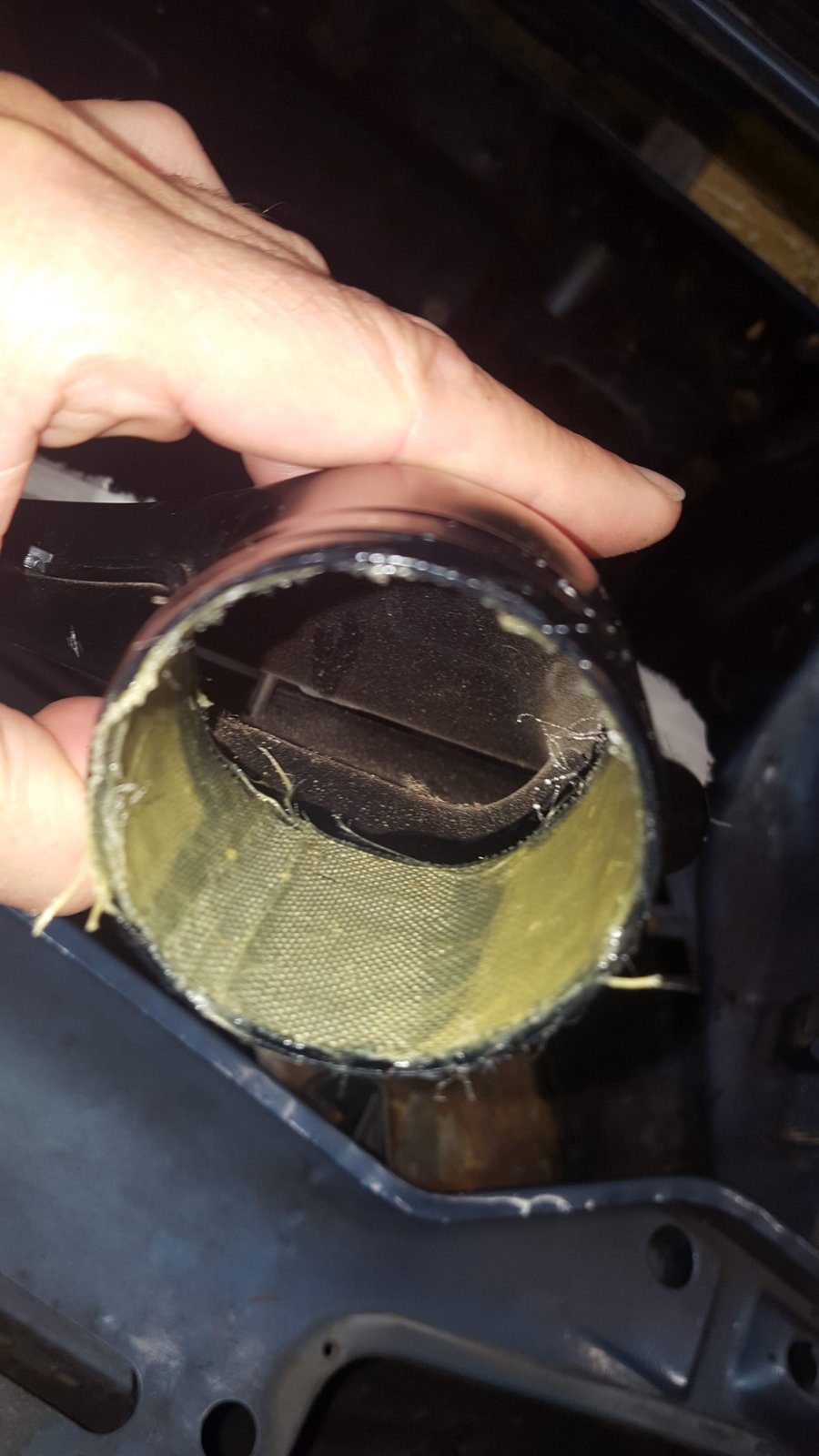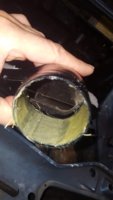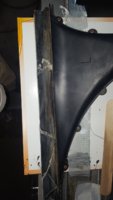Quoting Markos "My favorite build threads are the ones that highlight rust, sunk cost, accident damage, unexpected hiccups etc. " I agree. So here's the full saga of my defroster vents...
As most of you know, these brittle little buggers are NLA. The ones in my car were covered in a felt-like material, which, upon disassembling, I discovered was glued to the plastic and holding the multiple broken pieces together. A lot of effort from a PO. This meant that I not only had cracked and broken vents but they were also covered in glue. After a fruitless attempt to buy replacements, I decided I couldn't make them any worse so I might as well attempt to repair. Fortunately, most of the pieces were (mostly) there. One corner was missing and there was a hole where a couple other pieces came together but there was enough to work with. Unfortunately, I didn't shoot any real "before" photos.
If I were more talented I'm sure the best choice would be to make some molds and reproduce these parts for everyone to benefit from but I don't have the skills to even know where to start on that endeavor.
Instead, I started by trying to remove the glue from my broken bits. 3M General Purpose Adhesive remover didn't work. Acetone made the plastic gummy. I found best results by scraping the glue off with a razor blade. On the unexpected hiccups front, I will admit that while scraping, I broke two more pieces off one vent. Argh. It became abundantly clear that some sort of strengthening would be needed both to facilitate repair and prevent further damage.
Looking at vents installed in cars at shows I found that a) there are a lot of warped and cracked vents out there and b) one side is quite visible but the back side barely pokes up above the dash. It seemed to me that I could put a layer of fiberglass on the backside and it would not add any significant thickness nor be very visible. Using materials at hand (I used to repair carbon-Kevlar bodywork on racecars), I embarked on making my vents "bulletproof".
How they appear installed (car unknown):

I assumed (perhaps mistakenly) that another weak spot on the vents would be the round sections where the hose is man-handled on and off. Since I had some nice fine-weave Kevlar lying around, I lined the inside of the round portion with a layer of Kevlar and epoxy resin. In hindsight, I should have waited to do this. It would've been advantageous to drill out the rivets and disassemble the halves to make sanding easier when repairing the blades but I was so anxious to prove I could make them stronger that I jumped the gun. Sigh.
Aramid-fiber re-enforced. This puppy won't crack:

Anyway, after doing that, I began reassembling the various bits on the blade portion. Some (the fresh breaks) I was able to glue with Gorilla instant glue (crazy glue) while others didn't line up as well so I used quick-dry JB-Weld.


Once I had them in basically one piece, I put down a single layer of fiberglass on the backside. One trick that I learned in my old racing days is to use "peel ply" for smooth, thin wet lay-up repairs. I roughed up the surface, put down the cloth, brushed on some West Marine 105 epoxy resin, then covered with a strip of peel-ply and squeegeed out all excess resin. Once dry, you can pull the peel-ply off and it leaves a smooth(ish), strong thin layer of glass/resin. Not as good as vacuum bagging but super helpful in situations like this. The strengthening worked quite well. I just trimmed the edges and gave it a little sanding (that's why I used fiberglass instead of Kevlar or carbon cloth -- it sands better).


Now that they we almost in one piece and strong, I worked on filling the missing sections. Most were easy. The backing served to hold the repairs and I just made a slurry of resin and cut-up pieces of carbon fiber and was able to fill, then sand.
Unfortunately, one corner was missing and there was no broken piece to reconstruct it with. This was a challenge. I started by trying fiberglass but it didn't adhere well -- I didn't want to overlap much. I ended up making a wall with carbon fiber cloth to act as a form that I was then able to build on top off with a carbon/resin slurry. Many rounds of sanding and filling later, I had the basic shape back.




That's about the time that I found the missing plastic corner down on the floor of the car. Argh! Too late to use it, I was committed to repair now.
The missing link, subsequently stepped on (accidentally, not in frustration) and broken into three pieces itself:

A little auto-body filler to smooth things over, and lot more sanding, and I was ready to prime. I used SEM's Sand Free plastic prep to aid adhesion and shot some black primer, and sanded more, etc.





The last problem faced was getting a finish that approximates the color and sheen of black plastic. I started by trying SEM's plastic spray paint in "Landau Black" but the sheen was much too flat so I had to sand all that off. Sigh.
I ended up turning to my old friend, the Badger airbrush. I've had this thing for almost 40 years and I love it for small jobs like this. I have a real Iwata airbrush for "art" work but this old hobby-level Badger sprays just the right amount of paint -- more than a typical fine airbrush but less than a detail gun. And it has small jars and is easy to clean. I happened to have some Hot-Rod Restorations Semi-Gloss black left over from another car so I shot that it it came out pretty good. Now that I've written all this you might take a close look at my vents someday and you'll be able to tell that they have been painted/repaired but I suspect that if I didn't say anything no one would've noticed.

That's a long story for a small job, I'm not sure it is really that helpful because it is a lot of work and requires some fairly special materials but I didn't hide the hiccups along the way and I hope someone can glean something useful from my experience.


As most of you know, these brittle little buggers are NLA. The ones in my car were covered in a felt-like material, which, upon disassembling, I discovered was glued to the plastic and holding the multiple broken pieces together. A lot of effort from a PO. This meant that I not only had cracked and broken vents but they were also covered in glue. After a fruitless attempt to buy replacements, I decided I couldn't make them any worse so I might as well attempt to repair. Fortunately, most of the pieces were (mostly) there. One corner was missing and there was a hole where a couple other pieces came together but there was enough to work with. Unfortunately, I didn't shoot any real "before" photos.
If I were more talented I'm sure the best choice would be to make some molds and reproduce these parts for everyone to benefit from but I don't have the skills to even know where to start on that endeavor.
Instead, I started by trying to remove the glue from my broken bits. 3M General Purpose Adhesive remover didn't work. Acetone made the plastic gummy. I found best results by scraping the glue off with a razor blade. On the unexpected hiccups front, I will admit that while scraping, I broke two more pieces off one vent. Argh. It became abundantly clear that some sort of strengthening would be needed both to facilitate repair and prevent further damage.
Looking at vents installed in cars at shows I found that a) there are a lot of warped and cracked vents out there and b) one side is quite visible but the back side barely pokes up above the dash. It seemed to me that I could put a layer of fiberglass on the backside and it would not add any significant thickness nor be very visible. Using materials at hand (I used to repair carbon-Kevlar bodywork on racecars), I embarked on making my vents "bulletproof".
How they appear installed (car unknown):
I assumed (perhaps mistakenly) that another weak spot on the vents would be the round sections where the hose is man-handled on and off. Since I had some nice fine-weave Kevlar lying around, I lined the inside of the round portion with a layer of Kevlar and epoxy resin. In hindsight, I should have waited to do this. It would've been advantageous to drill out the rivets and disassemble the halves to make sanding easier when repairing the blades but I was so anxious to prove I could make them stronger that I jumped the gun. Sigh.
Aramid-fiber re-enforced. This puppy won't crack:
Anyway, after doing that, I began reassembling the various bits on the blade portion. Some (the fresh breaks) I was able to glue with Gorilla instant glue (crazy glue) while others didn't line up as well so I used quick-dry JB-Weld.
Once I had them in basically one piece, I put down a single layer of fiberglass on the backside. One trick that I learned in my old racing days is to use "peel ply" for smooth, thin wet lay-up repairs. I roughed up the surface, put down the cloth, brushed on some West Marine 105 epoxy resin, then covered with a strip of peel-ply and squeegeed out all excess resin. Once dry, you can pull the peel-ply off and it leaves a smooth(ish), strong thin layer of glass/resin. Not as good as vacuum bagging but super helpful in situations like this. The strengthening worked quite well. I just trimmed the edges and gave it a little sanding (that's why I used fiberglass instead of Kevlar or carbon cloth -- it sands better).
Now that they we almost in one piece and strong, I worked on filling the missing sections. Most were easy. The backing served to hold the repairs and I just made a slurry of resin and cut-up pieces of carbon fiber and was able to fill, then sand.
Unfortunately, one corner was missing and there was no broken piece to reconstruct it with. This was a challenge. I started by trying fiberglass but it didn't adhere well -- I didn't want to overlap much. I ended up making a wall with carbon fiber cloth to act as a form that I was then able to build on top off with a carbon/resin slurry. Many rounds of sanding and filling later, I had the basic shape back.
That's about the time that I found the missing plastic corner down on the floor of the car. Argh! Too late to use it, I was committed to repair now.
The missing link, subsequently stepped on (accidentally, not in frustration) and broken into three pieces itself:
A little auto-body filler to smooth things over, and lot more sanding, and I was ready to prime. I used SEM's Sand Free plastic prep to aid adhesion and shot some black primer, and sanded more, etc.
The last problem faced was getting a finish that approximates the color and sheen of black plastic. I started by trying SEM's plastic spray paint in "Landau Black" but the sheen was much too flat so I had to sand all that off. Sigh.
I ended up turning to my old friend, the Badger airbrush. I've had this thing for almost 40 years and I love it for small jobs like this. I have a real Iwata airbrush for "art" work but this old hobby-level Badger sprays just the right amount of paint -- more than a typical fine airbrush but less than a detail gun. And it has small jars and is easy to clean. I happened to have some Hot-Rod Restorations Semi-Gloss black left over from another car so I shot that it it came out pretty good. Now that I've written all this you might take a close look at my vents someday and you'll be able to tell that they have been painted/repaired but I suspect that if I didn't say anything no one would've noticed.
That's a long story for a small job, I'm not sure it is really that helpful because it is a lot of work and requires some fairly special materials but I didn't hide the hiccups along the way and I hope someone can glean something useful from my experience.



